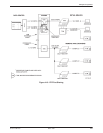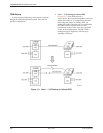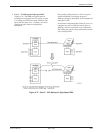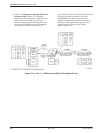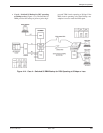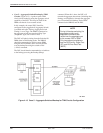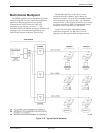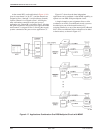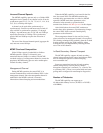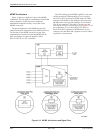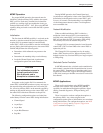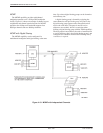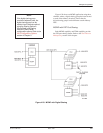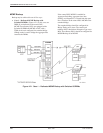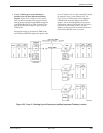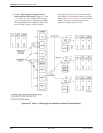
Principles of Operation
4-233610-A2-GB41-60 March 1999
Line and Channel Speeds
The MCMP capability operates only on a 56 kbps DDS
multipoint circuit. Speeds of any channel can be set to the
synchronous speed of 1.2, 2.4, 4.8, 7.2, 9.6, 12, 14.4, 16.8,
19.2, 38.4, or 48 kbps full-duplex.
A channel can be used either synchronously or
asynchronously. Possible asynchronous rates include all
rates available to synchronous operation (1.2 through
48 kbps). Asynchronous rates of 150, 300, and 1200 bps
require the allocation of 1200 bps. The asynchronous
speed of 600 and 1800 bps requires the allocation of
2400 bps.
The sum of the allocated channel speeds (aggregate bit
rate) must not exceed 48 kbps.
MCMP Overhead Composition
Of the 56 kbps capacity (bandwidth) available to
MCMP operation, 48 kbps is allocated to user-
transmitted data and 8 kbps is overhead. The MCMP
overhead consists of a management channel to control the
proprietary MCMP framing process and a nondisruptive
in-band secondary channel.
Management Channel
During MCMP operation, the control DSU is in
constant communication with each tributary DSU via the
management channel. Since the management channel is
embedded in the MCMP overhead, it transmits
information without disrupting user-transmitted data.
When the MCMP capability is activated for the first
time, the control DSU with MCMP determines the
roundtrip delay parameters that are critical to MCMP
operation. MCMP sends these parameters to the
tributaries in the network to synchronize their
transmissions. Refer to MCMP Operation in this chapter.
After initialization, the control DSU continues to
monitor these delay parameters. Upon detecting changes,
the control DSU sends corrected roundtrip delay
parameters to the tributaries.
The management channel is also used for framing,
where selection of an underspeed channel is not required.
This framing technique differs markedly from the in-band
framing scheme used by the TDM capability, where
framing bits may be implemented by reducing the data
rate of one of the channels.
In-Band Secondary Channel Transport
The MCMP capability supports in-band secondary
channel transport between the control and tributary DSUs
that can transport diagnostics without disrupting
user-transmitted data.
Some tests transmitted over the in-band secondary
channel transport may result in primary channel
disruptions when the test is executed ( i.e., a Device Test
to a tributary DSU). There is no routine health and status
polling unless configured for nondisruptive diagnostics.
Number of Tributaries
The MCMP capability can support up to
40 addressable tributary devices (40 DSUs or 20 DSUs
with DBMs).



